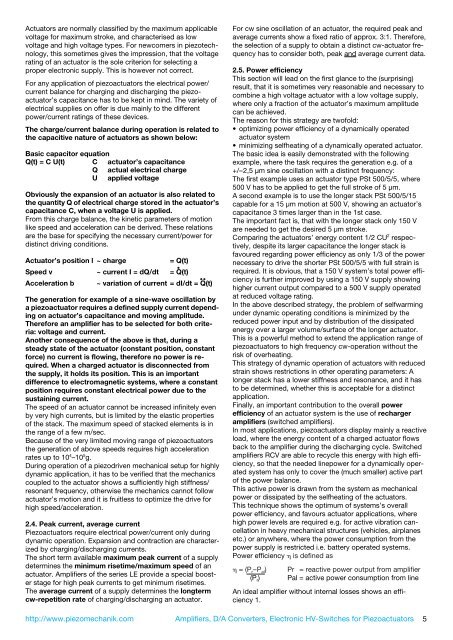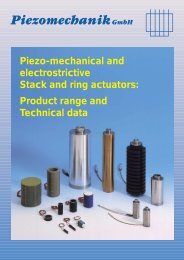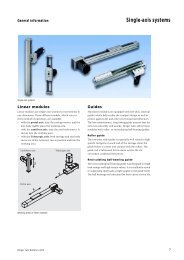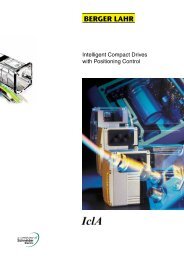Piezomechanik
Piezomechanik
Piezomechanik
Create successful ePaper yourself
Turn your PDF publications into a flip-book with our unique Google optimized e-Paper software.
Actuators are normally classified by the maximum applicable<br />
voltage for maximum stroke, and characterised as low<br />
voltage and high voltage types. For newcomers in piezotechnology,<br />
this sometimes gives the impression, that the voltage<br />
rating of an actuator is the sole criterion for selecting a<br />
proper electronic supply. This is however not correct.<br />
For any application of piezoactuators the electrical power/<br />
current balance for charging and discharging the piezoactuator’s<br />
capacitance has to be kept in mind. The variety of<br />
electrical supplies on offer is due mainly to the different<br />
power/current ratings of these devices.<br />
The charge/current balance during operation is related to<br />
the capacitive nature of actuators as shown below:<br />
Basic capacitor equation<br />
Q(t) = C U(t) C actuator’s capacitance<br />
Q actual electrical charge<br />
U applied voltage<br />
Obviously the expansion of an actuator is also related to<br />
the quantity Q of electrical charge stored in the actuator’s<br />
capacitance C, when a voltage U is applied.<br />
From this charge balance, the kinetic parameters of motion<br />
like speed and acceleration can be derived. These relations<br />
are the base for specifying the necessary current/power for<br />
distinct driving conditions.<br />
Actuator’s position l ~ charge = Q(t)<br />
.<br />
Speed v ~ current I = dQ/dt = Q(t)<br />
..<br />
Acceleration b ~ variation of current = dI/dt = Q(t)<br />
The generation for example of a sine-wave oscillation by<br />
a piezoactuator requires a defined supply current depending<br />
on actuator’s capacitance and moving amplitude.<br />
Therefore an amplifier has to be selected for both criteria:<br />
voltage and current.<br />
Another consequence of the above is that, during a<br />
steady state of the actuator (constant position, constant<br />
force) no current is flowing, therefore no power is required.<br />
When a charged actuator is disconnected from<br />
the supply, it holds its position. This is an important<br />
difference to electromagnetic systems, where a constant<br />
position requires constant electrical power due to the<br />
sustaining current.<br />
The speed of an actuator cannot be increased infinitely even<br />
by very high currents, but is limited by the elastic properties<br />
of the stack. The maximum speed of stacked elements is in<br />
the range of a few m/sec.<br />
Because of the very limited moving range of piezoactuators<br />
the generation of above speeds requires high acceleration<br />
rates up to 10 4 –10 5 g.<br />
During operation of a piezodriven mechanical setup for highly<br />
dynamic application, it has to be verified that the mechanics<br />
coupled to the actuator shows a sufficiently high stiffness/<br />
resonant frequency, otherwise the mechanics cannot follow<br />
actuator’s motion and it is fruitless to optimize the drive for<br />
high speed/acceleration.<br />
2.4. Peak current, average current<br />
Piezoactuators require electrical power/current only during<br />
dynamic operation. Expansion and contraction are characterized<br />
by charging/discharging currents.<br />
The short term available maximum peak current of a supply<br />
determines the minimum risetime/maximum speed of an<br />
actuator. Amplifiers of the series LE provide a special booster<br />
stage for high peak currents to get minimum risetimes.<br />
The average current of a supply determines the longterm<br />
cw-repetition rate of charging/discharging an actuator.<br />
For cw sine oscillation of an actuator, the required peak and<br />
average currents show a fixed ratio of approx. 3:1. Therefore,<br />
the selection of a supply to obtain a distinct cw-actuator frequency<br />
has to consider both, peak and average current data.<br />
2.5. Power efficiency<br />
This section will lead on the first glance to the (surprising)<br />
result, that it is sometimes very reasonable and necessary to<br />
combine a high voltage actuator with a low voltage supply,<br />
where only a fraction of the actuator’s maximum amplitude<br />
can be achieved.<br />
The reason for this strategy are twofold:<br />
• optimizing power efficiency of a dynamically operated<br />
actuator system<br />
• minimizing selfheating of a dynamically operated actuator.<br />
The basic idea is easily demonstrated with the following<br />
example, where the task requires the generation e.g. of a<br />
+/–2,5 µm sine oscillation with a distinct frequency:<br />
The first example uses an actuator type PSt 500/5/5, where<br />
500 V has to be applied to get the full stroke of 5 µm.<br />
A second example is to use the longer stack PSt 500/5/15<br />
capable for a 15 µm motion at 500 V, showing an actuator’s<br />
capacitance 3 times larger than in the 1st case.<br />
The important fact is, that with the longer stack only 150 V<br />
are needed to get the desired 5 µm stroke.<br />
Comparing the actuators’ energy content 1/2 CU 2 respectively,<br />
despite its larger capacitance the longer stack is<br />
favoured regarding power efficiency as only 1/3 of the power<br />
necessary to drive the shorter PSt 500/5/5 with full strain is<br />
required. It is obvious, that a 150 V system’s total power efficiency<br />
is further improved by using a 150 V supply showing<br />
higher current output compared to a 500 V supply operated<br />
at reduced voltage rating.<br />
In the above described strategy, the problem of selfwarming<br />
under dynamic operating conditions is minimized by the<br />
reduced power input and by distribution of the dissipated<br />
energy over a larger volume/surface of the longer actuator.<br />
This is a powerful method to extend the application range of<br />
piezoactuators to high frequency cw-operation without the<br />
risk of overheating.<br />
This strategy of dynamic operation of actuators with reduced<br />
strain shows restrictions in other operating parameters: A<br />
longer stack has a lower stiffness and resonance, and it has<br />
to be determined, whether this is acceptable for a distinct<br />
application.<br />
Finally, an important contribution to the overall power<br />
efficiency of an actuator system is the use of recharger<br />
amplifiers (switched amplifiers).<br />
In most applications, piezoactuators display mainly a reactive<br />
load, where the energy content of a charged actuator flows<br />
back to the amplifier during the discharging cycle. Switched<br />
amplifiers RCV are able to recycle this energy with high efficiency,<br />
so that the needed linepower for a dynamically operated<br />
system has only to cover the (much smaller) active part<br />
of the power balance.<br />
This active power is drawn from the system as mechanical<br />
power or dissipated by the selfheating of the actuators.<br />
This technique shows the optimum of systems’s overall<br />
power efficiency, and favours actuator applications, where<br />
high power levels are required e.g. for active vibration cancellation<br />
in heavy mechanical structures (vehicles, airplanes<br />
etc.) or anywhere, where the power consumption from the<br />
power supply is restricted i.e. battery operated systems.<br />
Power efficiency � is defined as<br />
� = (P r–P al) Pr = reactive power output from amplifier<br />
� = (P r) Pal = active power consumption from line<br />
An ideal amplifier without internal losses shows an efficiency<br />
1.<br />
http://www.piezomechanik.com Amplifiers, D/A Converters, Electronic HV-Switches for Piezoactuators<br />
5






